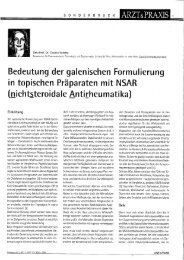Diclofenac Sodium 4% Spray Gel - cyathus.cz
Diclofenac Sodium 4% Spray Gel - cyathus.cz
Diclofenac Sodium 4% Spray Gel - cyathus.cz
Create successful ePaper yourself
Turn your PDF publications into a flip-book with our unique Google optimized e-Paper software.
PAR <strong>Diclofenac</strong> <strong>Sodium</strong> <strong>4%</strong> <strong>Spray</strong> <strong>Gel</strong><br />
UK/H/0562-3/001/E01<br />
PIL. All of the excipients used in DSG <strong>4%</strong> are regularly used in pharmaceutical formulations<br />
and do not raise any safety concerns at the proposed levels and dose regimen.<br />
EXPERT REPORT<br />
A satisfactory pharmaco-toxicological Expert Report has been submitted with an appropriate<br />
CV. The report consists of a review of published literature on the pharmacology and<br />
toxicology of diclofenac sodium. In addition, preclinical studies performed with the proposed<br />
formulation are discussed; these include a local tolerance study in rabbits and an in vitro skin<br />
penetration study using human abdominal skin.<br />
SUMMARY OF PRODUCT CHARACTERISTICS<br />
The SPC is satisfactory.<br />
DISCUSSION<br />
DSG <strong>4%</strong> was well absorbed after in vitro topical administration, 2.5% completely permeated<br />
the skin, 47% in the stratum corneum and 36% in the deeper skin layers. In vitro percutaneous<br />
absorption of DSG <strong>4%</strong> was about 21 times that of Voltaren ® Emulgel (1.16% diclofenac<br />
diethylammonium), and resulted in higher diclofenac concentrations in the deeper skin layers.<br />
Given the synovial fluid/tissue concentrations obtained with Voltaren ® Emulgel, it is<br />
anticipated that after the application of DSG <strong>4%</strong> to arthritic patients, plasma levels of parent<br />
drug would be lower than in synovial fluid/tissues.<br />
In rabbits, systemic availability of diclofenac attained with DSG <strong>4%</strong> was twice that attained<br />
with an equivalent dose of Voltaren ® Emugel. However, in human volunteers, systemic<br />
availability of diclofenac achieved with DSG <strong>4%</strong> was considerably lower than that attained<br />
after an equivalent oral dose of Voltaren 50mg tablets. Therefore, previous safety margins<br />
estimated for oral diclofenac formulations are unlikely to be eroded following topical<br />
administration of DSG <strong>4%</strong> to humans.<br />
DSG <strong>4%</strong> was non-irritant to rabbit skin and would probably be well tolerated after topical<br />
administration.<br />
CONCLUSIONS<br />
There are no preclinical objections to the granting of Marketing Authorisations for <strong>Diclofenac</strong><br />
<strong>Spray</strong> <strong>4%</strong> <strong>Gel</strong>.<br />
III.3 CLINICAL ASPECTS<br />
CLINICAL PHARMACOLOGY<br />
The clinical expert report provides a bibliographic review of the clinical<br />
pharmacology of diclofenac, including a brief summary of two pharmacokinetic<br />
studies in 12 volunteers.<br />
Pharmacodynamics<br />
<strong>Diclofenac</strong> is a phenylacetic acid derivative, one of the group of non-steroidal antiinflammatory<br />
drugs whose action is mediated by inhibition of enzymes of the cyclooxygenase<br />
type that are essential for the production of prostaglandins. Reduced<br />
prostaglandin synthesis is believed to be responsible for the anti-inflammatory and<br />
analgesic activities.<br />
25



